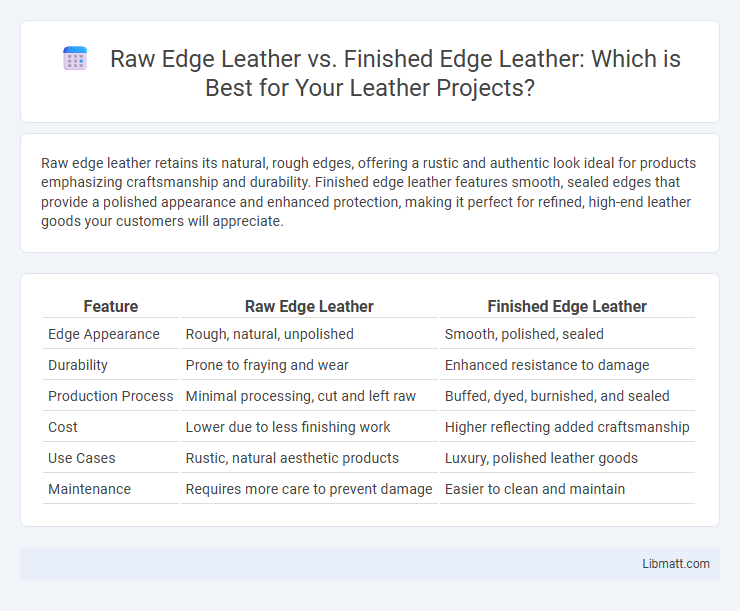Raw edge leather retains its natural, rough edges, offering a rustic and authentic look ideal for products emphasizing craftsmanship and durability. Finished edge leather features smooth, sealed edges that provide a polished appearance and enhanced protection, making it perfect for refined, high-end leather goods your customers will appreciate.
Table of Comparison
| Feature | Raw Edge Leather | Finished Edge Leather |
|---|---|---|
| Edge Appearance | Rough, natural, unpolished | Smooth, polished, sealed |
| Durability | Prone to fraying and wear | Enhanced resistance to damage |
| Production Process | Minimal processing, cut and left raw | Buffed, dyed, burnished, and sealed |
| Cost | Lower due to less finishing work | Higher reflecting added craftsmanship |
| Use Cases | Rustic, natural aesthetic products | Luxury, polished leather goods |
| Maintenance | Requires more care to prevent damage | Easier to clean and maintain |
Introduction to Leather Edges
Raw edge leather reveals the natural, unfinished side of the material, showcasing the fibrous texture and offering a rustic, authentic aesthetic. Finished edge leather undergoes processes such as sanding, dyeing, and sealing, producing smooth, polished edges that enhance durability and visual refinement. The choice between raw and finished edges impacts both the tactile experience and longevity of leather goods.
What is Raw Edge Leather?
Raw edge leather is leather that has not undergone any edge finishing processes, leaving its natural, fibrous edges exposed and unsealed. This type of leather showcases a rustic, authentic look, often preferred in handmade or artisanal leather goods for its natural aesthetic. Your choice of raw edge leather emphasizes durability and character, as it allows the material's natural texture and thickness to remain visible and tactile.
What is Finished Edge Leather?
Finished edge leather refers to leather whose edges are treated and sealed through sanding, dyeing, and coating processes to create a smooth, polished appearance that enhances durability and prevents fraying. This treatment often includes the application of edge paint or edge sealant, which not only improves aesthetics but also protects the leather from moisture and wear. Commonly used in high-quality leather goods like wallets, belts, and bags, finished edge leather delivers a refined, professional look compared to the natural, rugged texture of raw edge leather.
Visual Appeal: Raw vs Finished Edges
Raw edge leather showcases the natural, rugged texture of the leather's side, providing an organic and rustic visual appeal favored in artisanal and vintage designs. Finished edge leather, by contrast, features smooth, polished, and often sealed edges that create a refined and professional look, enhancing durability and sophistication. The choice between raw and finished edges significantly impacts the overall aesthetic, with raw edges emphasizing authenticity and finished edges delivering elegance and precision.
Durability Comparison
Raw edge leather offers superior durability due to its thicker, untreated edges that resist wear and tear over time. Finished edge leather, while aesthetically polished with sealed and dyed edges, may be more prone to cracking and fraying as the protective finish can deteriorate. The inherent toughness of raw edge leather makes it preferable for heavy-use items requiring long-lasting resilience.
Craftsmanship and Skill Required
Raw edge leather demands advanced craftsmanship due to its exposed, untreated edges that require precise cutting, burnishing, and sealing to prevent fraying while maintaining a natural look. Finished edge leather involves more standardized finishing processes, such as sanding, painting, or glazing the edges, making it less labor-intensive but still requiring skill to achieve a smooth, uniform appearance. The choice between raw edge and finished edge leather highlights a craftsman's expertise in both delicate handwork and mastery of finishing techniques.
Maintenance and Longevity
Raw edge leather, with its natural, untreated edges, requires regular conditioning and careful cleaning to prevent drying and cracking, which can affect its durability. Finished edge leather features sealed and polished edges that offer enhanced protection against moisture and wear, leading to longer-lasting performance with less frequent maintenance. Proper care tailored to each type significantly influences the leather's longevity, making finished edge leather generally more resilient over time.
Cost Differences
Raw edge leather generally costs less than finished edge leather due to minimal processing and simpler manufacturing steps. Finished edge leather involves additional labor, edge treatment, and sealing processes, increasing production expenses and retail prices. Choosing between raw edge and finished edge leather impacts overall project budget based on desired aesthetics and durability requirements.
Suitable Applications and Uses
Raw edge leather is ideal for artisanal projects like handmade wallets, belts, and rustic-style footwear due to its natural, unfinished look and ability to develop a unique patina over time. Finished edge leather is commonly used in high-end fashion accessories, upholstery, and formal footwear where a polished, smooth, and refined appearance is essential. Both types serve distinct purposes, with raw edges offering durability and character in casual settings, while finished edges provide a sleek, professional finish for luxury products.
Choosing the Right Edge for Your Project
Raw edge leather preserves the natural, unfinished side of the hide, offering a rustic and organic look perfect for artisanal or vintage-style projects. Finished edge leather features a polished and sealed edge, enhancing durability and providing a sleek, professional appearance ideal for high-use items like wallets or belts. Selecting the right edge depends on the desired aesthetic, durability requirements, and the specific function of the leather project.
Raw edge leather vs finished edge leather Infographic

 libmatt.com
libmatt.com